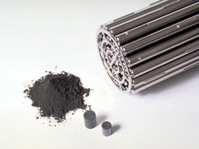Chinese firms have agreed a strategy towards recycling uranium for use again in Candu reactors.
 |
| Candu reactor fuel. Why not use uranium left over from use in another reactor? (Image: Cameco) |
The four partners will jointly develop the technology for the use of uranium recovered from used nuclear fuel from other Chinese reactors for use at Qinshan 3 and 4. This follows a deal earlier this year between AECL and NPIC to conduct research in this area.
Qinshan 3 and 4 are pressurized heavy water reactors (PHWRs) designed to run on natural uranium fuel - that is, composed of about 0.7% uranium-235 and not enriched to increase this. They differ from the bulk of China's current and future nuclear fleet, which is based on pressurized water reactors (PWRs) running on low-enriched uranium (about 5% U-235).
Once the fuel from the PWRs has been used for a certain time, its effective enrichment level drops beyond the point it is useful for generating electricity. However, the mix of uranium within the used fuel could in theory still be used in a Candu reactor. In this way, PHWR and PWR units could be operated in a symbiotic way which recycles uranium. It is this that the companies hope to achieve.
AECL president and CEO Hugh MacDiarmid said: "Candu nuclear technology has the potential to make a major contribution to reducing China's dependence on imported nuclear fuel resources."
Uranium recovered from used nuclear fuel differs from natural uranium in its isotopic makeup, which remains slightly enriched (about 1.6% U-235), with a heightened level of radioactivity. These differences as well as the highly radiaoctive nature of the used PWR fuel pose the technical challenges the four partners need to overcome.
A program in South Korea has pursued similar goals for some time. Dupic (Direct Use of PWR fuel in Candu) envisages the used fuel pellets from PWR fuel being broken up heated to drive off radioactive fission products and then reformed for use in Candu fuel. It is not yet clear whether the Chinese project matches this or whether intermediate steps of chemical and physical processing would be carried out. Using Candu reactors in a similar way is also under investigation in Ukraine.
MacDiarmid said that besides using recovered uranium, the four are also to set up a program to demonstrate the use of thorium in a Candu reactor, avoiding the use of uranium altogether. AECL said it had investigated this option for over 45 years, with promising results. While uranium is already the cheapest fuel for electricity generation, even for reactors where the enrichment step is required, thorium would be cheaper still.




_47120.jpg)

_23621.jpg)






